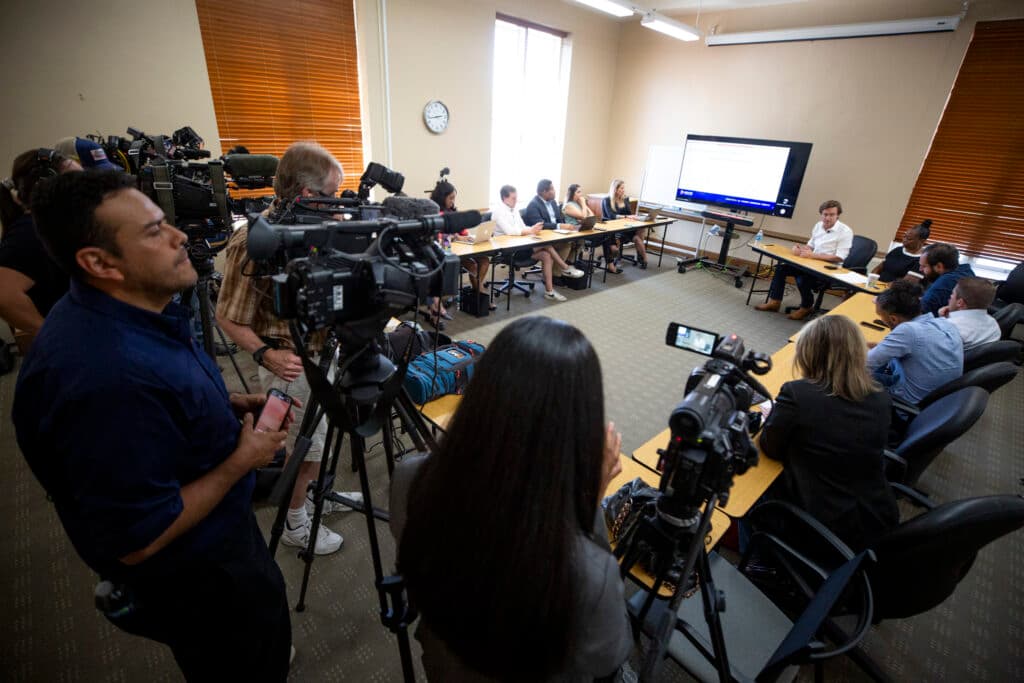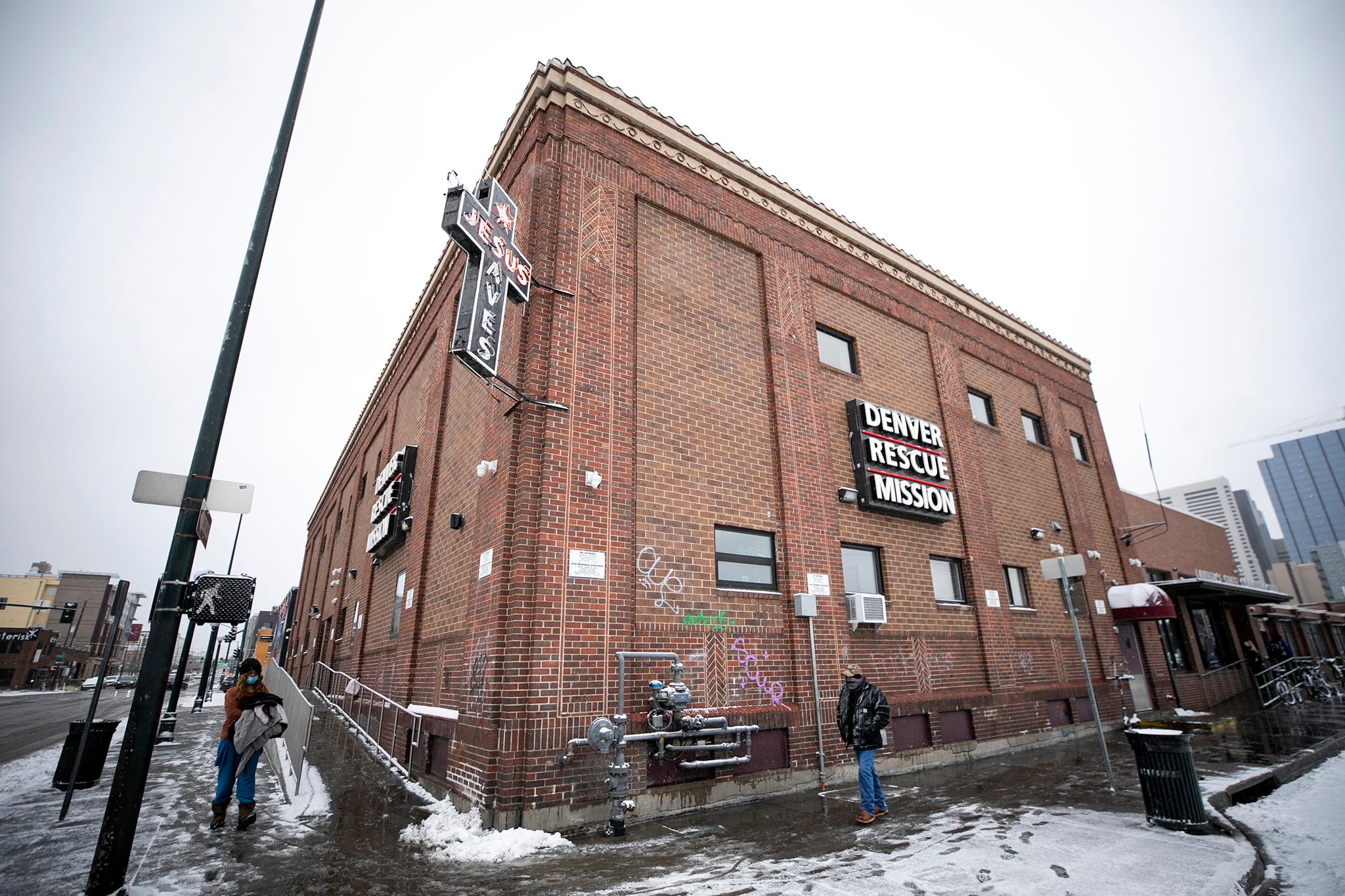The city of Denver hasn’t cut this many jobs since the Great Recession.
In all, Mayor Mike Johnston’s administration laid off 171 employees and closed nearly 700 open jobs. It started on Monday, and by Tuesday it was all over — but the consequences could play out for years.
“Our layoffs and furloughs are finished,” Johnston said at a press conference on Wednesday.
The layoffs did not touch the city’s police or fire departments, which together make up the biggest part of general fund spending. Instead, the layoffs focused on what Johnston called “internal facing” positions — with the cuts including city planners, housing and homelessness specialists, a spokesperson for the finance department and scores of others.
The cuts will not result in changes to city services like trash pickup, facility operating hours, or services for developers, Johnston said. But overall, the city will have to follow a new mantra: “Let’s do less and let’s do it better,” he said.

It was the largest city layoff since The Great Recession, when Mayor John Hickenlooper cut 170 jobs in 2009. (This year’s official layoff count will be 169, since two people resigned instead.)
In all, the city cut $21 million in annual spending through the layoffs and another $70 million by eliminating open positions. The city will still have to make another $100 million in cuts to city contracts, supply purchases and services to balance next year’s budget.
The mayor defended the cuts as painful but necessary, saying the city’s spending had grown too much over the last decade — leaving it unprepared for an economic slowdown and declining revenues.
What city departments were hit the hardest?
As Johnston pointed out early and often on Wednesday, the number of active police officers, sheriff’s deputies and firefighters won’t be reduced. But the safety agencies did lose open positions — 61 in the Denver Sheriff Department, 10 in the police department and 16 in the fire department.
The city’s Human Rights Office and Office of Children’s Affairs saw some of the heaviest cuts. The city laid off 19 people and cut 10 positions between the two agencies, representing more than a third of their budgeted staff.
The city's climate office was close behind, losing about 28 percent of its staff, including five layoffs and 22 position closures.
The Department of Transportation and Infrastructure saw the largest number of job cuts, with 31 layoffs and 108 closed positions — almost a tenth of its budgeted staff in total. It is one of the largest agencies.
Meanwhile, the Denver Public Library, another large agency, lost 99 open positions but didn’t have any layoffs.
Spending has grown across city agencies in recent years. Public safety has seen the largest increase in terms of dollars spent. But smaller agencies have seen a faster rate of increase. For example, the parks budget has increased by 65 percent — a total of $63 million — since 2015. Other agencies have similarly added tens of millions to their budgets.
Cuts for other departments could still be coming. The city's Human Services department is "undergoing its own cost-savings plan due to state and federal unfunded mandates," according to a city press release. The city also will consider a "consolidation" as the Arts and Venues department absorbs the Office of Special Events.
What kinds of workers were laid off?
The city followed a new playbook with these rules.
In the past, the city followed seniority rules, laying off the newest employees while protecting those who had served longest.
This time, seniority was just one of several factors. Johnston said the change was necessary to keep the city’s workforce efficient. Other factors this time included skills, ability and performance.
Workers of all ages were laid off, including 20 who had served more than 15 years in the city. The layoffs hit about 40 supervisors and other leaders.

But the layoffs did not "disproportionately" impact the longest tenured employees, city officials said. The greatest portion of layoffs fell on those who had worked between 6 months and 5 years at the city, making up 44 percent of layoffs and about 37 percent of the workers who could be laid off
Women made up 57 percent of the layoffs, despite only representing about 52 percent of the potential layoffs. Meanwhile, the city claimed the layoffs among racial and ethnic groups were roughly proportional, given the “small sample size.” White people were somewhat underrepresented, making up 42 percent of layoffs but 49 percent of layoff-eligible workers.
Blowback building
The cuts have drawn fierce criticism from some city leaders. Clerk and Recorder Paul López claimed the firings were “a deliberate, hand-selected purge” and a "betrayal" of city workers.
Meanwhile, Councilmember Stacie Gilmore’s husband, Scott Gilmore, was laid off from an executive position in the parks department. Infuriated, she implied that it was an act of political retaliation and promised more fireworks to come, saying her “dog muzzle” had been taken off.
Johnston sharply dismissed claims of retaliation or a purge.
“It’s irresponsible and factually false,” he said on Wednesday.
He also responded to criticism that his administration has been fiscally irresponsible with its spending on homelessness and immigration responses.
“This budget is a sign that we are fiscally responsible,” he said.
Councilmember Sarah Parady offered a mix of criticism and support in an interview with City Cast Denver published Wednesday morning.
“I’m glad that it wasn’t more people … I am really sad for each of those human beings and their families,” she told host Paul Karolyi. Some had speculated the layoffs could hit thousands of workers.
But Parady worried, she said, that cutting seniority rights could damage one of the main reasons people work in government — the promise of a long, stable career. And like others, she said the new approach could open the door for politically motivated layoffs.
“I’m worried that we’re going to see a lot of people laid off who may have been critical of the mayor in the past or who may have been sort of crosswise with their agency because of … having like blown the whistle,” Parady said.
She also warned that cutting vacant jobs could have unintended consequences. Choosing cuts based on which jobs “happened to be open” may not be a strategic approach, she said. But she said it’s still preferable to layoffs.
The end of years of growth?
The layoffs represent a sobering inflection point for a city that had gotten used to growth. The city’s economic engine roared after the pandemic, with general fund revenues soaring after the pandemic-era crash. But a slowing economy has dragged that growth down year after year.
The city’s general fund saw practically no revenue growth in 2025, and it’s expected to shrink in 2026. Except for during the pandemic, that hasn’t happened since the Great Recession. That’s mostly driven by declining sales tax collections.

Meanwhile, the city’s spending has grown sharply. Since 2012, the city’s workforce expanded by 40 percent and the inflation-adjusted cost of government services and supplies grew 70 percent. At the same time, the city’s population grew by about 15 percent.
As a result, a budget crunch has been looming larger in recent years. The city has spent down its reserves since 2022, reducing its rainy day fund by half. Johnston says the city has tried to avoid this outcome, including by reducing spending, freezing hiring in May and establishing a “position review committee” in 2023.
The city has also spent hundreds of millions on its responses to immigration and homelessness in recent years, though Johnston argues that did not create the deficit.
The city can not afford to keep spending at this rate, Johnston has warned.
“The first goal this year is to stop the bleeding and make sure we're not dipping into that fund balance anymore, and then focus on refilling,” Johnston told council members last week. “We think the better path is to put us on stable ground, work on a path for growth and recovery, and then really prioritize with your partnership that plan to restore that fund balance.”













